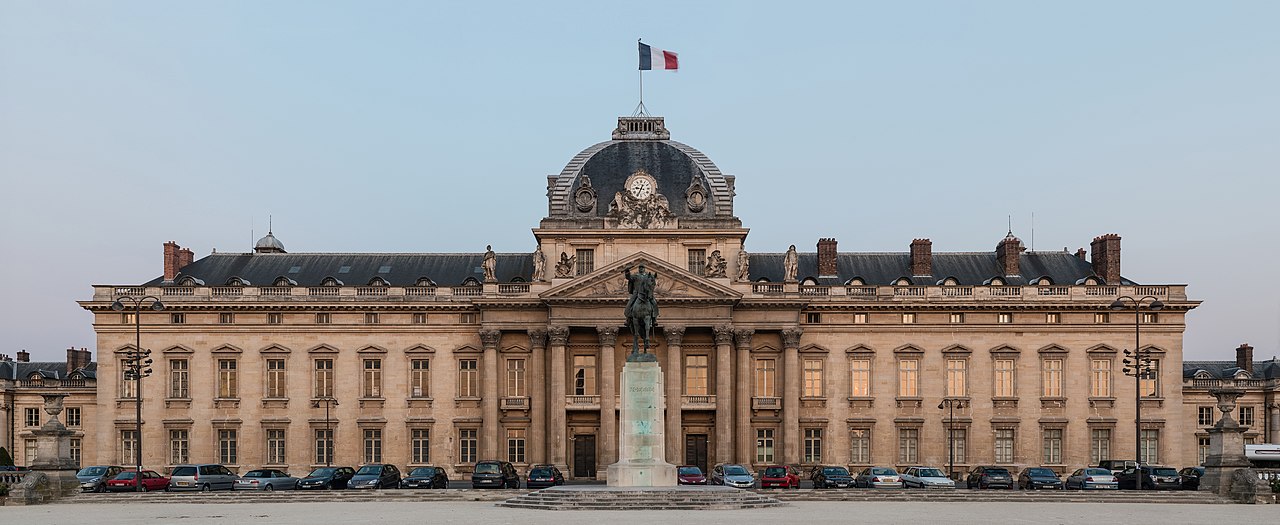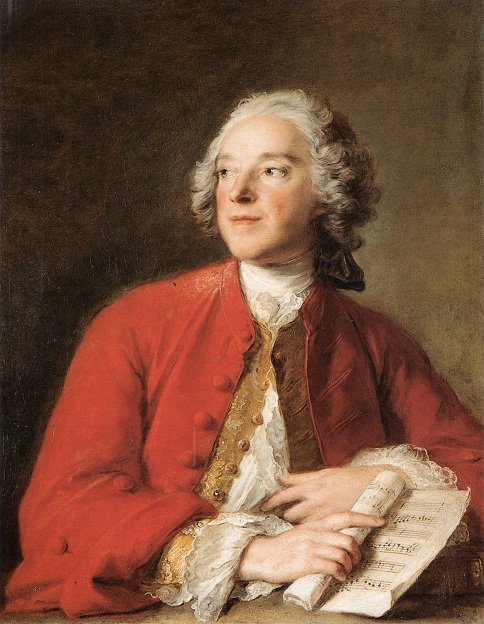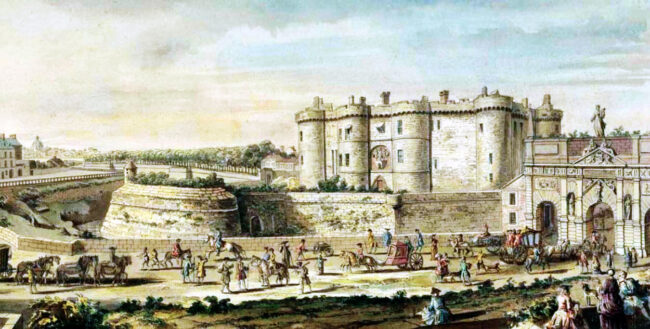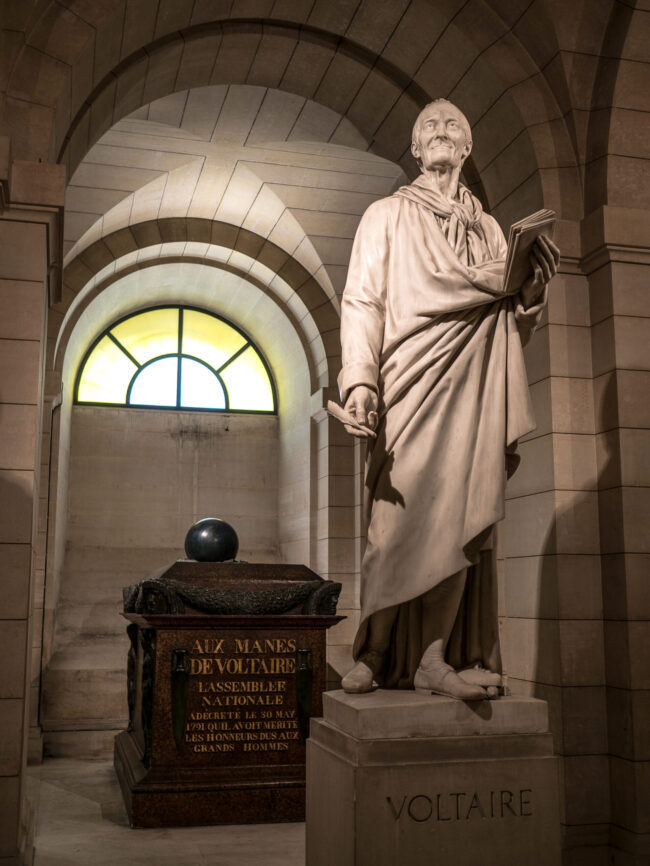The Smart Side of Paris: The Man Who Destroyed the Bastille
If you walked from the Place de la Bastille to the Place des Vosges along Rue Saint Antoine without noticing the statue of Caron de Beaumarchais in the tiny plaza at the corner of Saint Antoine and Rue des Tournelles, you would be forgiven. There isn’t much to the statue; it stands on a high pedestal, making it easy to miss, and there is no plaque explaining who he is or why he is important in French history. It is made of copper (and has turned green), and sometimes sports indecorous stickers announcing a band or a protest. People simply don’t linger at this busy, fast-paced intersection. You probably would not notice, either, that a large, pretty street named Boulevard Beaumarchais runs off the Place de la Bastille. And if you stayed at the Hotel Caron de Beaumarchais just off the Rue de Rivoli, you wouldn’t think twice about the name. And certainly if you wandered the very touristy Montmartre area, you would surely miss (as I almost did) the little Rue Ballu, where there are several buildings devoted to writers. One of these buildings is labeled the “Société des Auteurs et Compositeurs Dramatiques” (Society of Dramatic Authors and Composers). Here is a picture of one wall of the beautiful courtyard, which indicates that the society was founded by Beaumarchais in 1777.

Courtyard wall of the Society of Dramatic Authors and Composers. Photo credit: John Eigenaeur
Who was this Beaumarchais? And why does his name pop up all over Paris?
One hardly knows whether to call Beaumarchais a child of the Enlightenment or a Renaissance man. Like the latter, he seemed to be interested in everything; like the former, he seemed to believe everything possible. His biographer wrote of him that, “Of all the famous men of the eighteenth century, he is probably the one about whom the greatest number of fabulous statements have circulated.” Why? Because it nearly impossible to imagine any one person doing so many things in one lifetime, which is probably why Beaumarchais himself wrote, “If time were measured by the events that filled it, I have lived two hundred years.” I think he underestimated.
Beaumarchais’ adventures began innocently enough as a watchmaker, like his father. Inquisitive, creative, and inventive, Beaumarchais invented a mechanism that allowed pocket watches to keep time more accurately, as they notoriously needed to be reset regularly. His mentor, the royal watchmaker, promptly stole his invention and passed it off as his own. Beaumarchais was righteously indignant and fought back, claiming the invention was his. He won, his mentor was disgraced, and Beaumarchais was named “Purveyor to the King.”

Jean-Marc Nattier, Marie Adelaïde de France, dite Madame Adélaïde, daughter of Louis XV (1758), château de Versailles. Public domain
With connections at court, the crown soon learned of his musical talent, developed from a young age, and he became the musical tutor to the king’s four daughters. At court, he mingled with the aristocracy and began writing short plays for the wealthy. One of these admirers, the powerful Jospeh Pâris-Duverney, lacked the king’s permission to build the École Militaire, which now stands at the end of the Champs de Mars and is reflected in the magnificent glass front of the Grand Palais Éphemere. He turned to Beaumarchais for help, who leveraged his influence at court into the king’s consent. No Beaumarchais, no École Militaire. He was 28 years old. And those are the events of roughly the first 16 pages of his biography.

The central building of the École Militaire Complex in the 7th arrondissement of Paris at dusk. by DXR / Daniel Vorndran / Wikimedia Commons
Captivatingly restless, Beaumarchais could not make watches or tutor princesses for very long. Knowing intuitively that everything depended upon connections, Beaumarchais set off for Spain under the pretense of rescuing his sister from a duplicitous suitor while actually planning to negotiate business contracts with the king of Spain. He dived into Spanish high society, “visiting the ambassadors of France, England, and Russia, taking his place as a favorite of their wives.” He was charming, debonair, sophisticated, and carefree.
But he was no dilettante. He studied political economy, the Spanish empire, international relations, agriculture, and philosophy, all with the aim of being the impetus behind unifying Spain and France “against their common adversary, England.”
“I do not want small stuff,” he wrote, “Everything or nothing.” And yet, his Spanish venture resulted in the latter: nothing.

Jean-Marc Nattier, Portrait de Pierre-Augustin Caron de Beaumarchais (1755)
Undeterred, in this “everything or nothing” spirit, he launched a new business that consumed his days. But his nights were free, and he decided, as a matter of “amusement,” to write plays. He dusted off an old effort, Eugénie; it failed; he succeeded in getting his second play, The Two Friends, performed; it flopped worse than Eugénie. Shortly thereafter, his daughter died, then his wife passed away; finally, his only son died before his fourth birthday. What followed, in his biographer’s words, was “disgrace, dishonor, prison, and ruin.”
Beaumarchais may have been the first person to write himself out of prison. Incarcerated unjustly by a series of lies, bribes, and defamations, he turned to the pen, writing a series of satirical legal briefs in his own defense titled Memoranda Against Goëzman that captivated the attention and conversation of the Parisian public. In the first three briefs, he exposed his enemies as profligate liars unworthy of the honorable positions they held in society. Voltaire wrote to d’Alembert (!) of Beaumarchais, “What a man! He unites everything—humor, seriousness, argument, gaiety, force, pathos, every kind of eloquence…”
The Memoranda had the effect of exposing the calumny that landed him in prison, the courts recognized the injustice, his enemies were vanquished, and he was a free man. He immediately set about leading the rehearsals of a play that he had written: The Barber of Seville. Once the requisite permissions were granted to perform it in public, tickets sold out immediately. Even the queen could not wait to attend. And then, two days before the performance, the government shut the play down and banned its performance on the grounds of its irreverence toward authority. Within hours of the ban, the fourth and final issue of the Memoranda left the presses and all 6,000 copies were sold tout de suite. Once again, Voltaire chimed in: “I was never so amused! Heavens what roguery!” And then, a few months later, the Paris Parliament ordered the Memoranda burned in public and Beaumarchais stripped of his civil rights. “Banished from society, consigned to civil death, his career was ruined.” Amidst this turmoil, a warrant was issued for his arrest; he escaped by ship to England, where he soon became a secret agent for the very king who had ordered his arrest, banned his play, and burned his essays. I simply cannot put more into a paragraph.

A scene from a 19th-century version of The Barber of Seville. Its origins in the commedia dell’arte are shown in this picture, which portrays Figaro dressed in the costume and mask of Harlequin. Unknown artist. Public domain
His travels to England and then across the continent in pursuit of libelous authors to bribe into silence is the stuff of picaresque novels; Candide, Lazarillo de Tormes, and Tom Jones have little up on Beaumarchais. But his successes bought him exoneration — and his citizenship — and he was once again a free man in Paris. The first order of business was to resurrect his banned play, The Barber of Seville: Beaumarchais never gave up. Incredibly, it opened on February 23, 1775. It was a terrific failure; critics excoriated the author and his work; the public hissed.
But Beaumarchais, a man of infinite resilience, pared the play down from five acts to four in a matter of three days. The result was a complete success greeted by “thunderous applause.” In the first act, the barber reflects: “In one place they greeted me with open arms, the next they locked me up; wherever I went I rose above it; praised by some, condemned by others, taking risks when I was on a winning streak, cutting my losses when I wasn’t; paying no attention to fools and not afraid of villains.” Could the author reveal more of himself through his hero?

During the American Revolutionary War, French (left) and British ships (right) at the Battle of the Chesapeake off Yorktown in 1781; the outnumbered British fleet departed, leaving Cornwallis no choice but to capitulate. Credit: US Navy Naval History and Heritage Command. Public domain
Despite being back in Paris for the opening of his play in February of 1775, he returned to England to continue his espionage. Not content merely with bribing into silence the king’s slanderers, Beaumarchais invented a new mission for himself and his country: America’s freedom. He recognized from the first shots at Lexington that “the cause of America is in many respects the cause of humanity” (his words). Ever ready for new challenges, Beaumarchais inundated the French court with letters and reports encouraging France to come to America’s aid in her rebellion against Britain.
Since the king was indecisive, Beaumarchais created a plan for him. He would create a company under a false name that would trade with America. He would ship all the necessary military supplies to the rebels and would receive in return various staples from the colonies (such as tobacco) that could be sold at a profit. Eventually, he wore the king down and received permission for his venture, knowing full well that if he were discovered, the king would claim he knew nothing of Beaumarchais.
The effort, planning, and logistics required a superhuman effort. He coordinated ships, “maritime suppliers, ship handlers, warehouse owners, managers and dockers.” He bought 40,000 guns, enough cloth for 30,000 uniforms, 300,000 units of canon powder, 100,000 shells, not to mention over a million buttons for the uniforms. He coordinated ships coming and going, planning different routes to escape British suspicion, and even created an elaborate plan to make it appear that his ships were being seized while they were in the very act of delivering goods.
Thomas Jefferson wrote that Beaumarchais “has excited our greatest veneration by his affection for the true rights of man.” Silas Deane reported to Congress that Beaumarchais, “more than any other person” assisted the American cause. Voltaire may have provided the ideological backbone for the Revolution, and Jefferson may have put it into words, but Beaumarchais supplied the guns.
In the years that Beaumarchais was supporting the American Revolution with phenomenal amounts of time, energy, and money, he entertained himself writing one of the most brilliant, influential, and lasting pieces of theater ever created: The Marriage of Figaro. He finished it in 1778, but it remained unknown for several years. Even then, the play was read only in private as Beaumarchais passed it around Parisian salons, “enrolling all of Paris in a conspiracy of curiosity.” Once again his ideas were off in a whirlwind of controversy. The censor approved it, people talked about it everywhere without having seen it, and the king rejected it, commenting, “This man mocks everything that should be respected in a government.”

The Marriage of Figaro. Act 1: Cherubino hides behind Susanna’s chair as the Count arrives. Public domain
The chess match was on. Beaumarchais changed some parts of the play to make it less openly critical of French royalty and privilege, and added the brilliant line, “Only little men are afraid of little jokes,” daring the nobility not to laugh at themselves. The ban produced the desired effect of driving curiosity, and high society literally begged for readings, which Beaumarchais coyly denied until eventually surrendering. Still, a second attempt at gaining royal approval failed as the king commented that for the play to be performed, the Bastille would have to be destroyed — such was the power of the dialogue. In due time, however, the king’s brother prevailed upon him to have the play performed at Versailles, and the king relented. But after thirty days of rehearsals by professional performers, the king once again changed his mind only hours before the performance, and once again banned its performance. Three months later, he reversed his decision again and the play was to be performed in front of the highest levels of society.

The Bastille Prison in 1715. Rigaud, 18th century – Bibliotheque Nationale de France. Public domain
When The Marriage of Figaro was finally performed in public on April 27, 1784, it was the greatest theatrical success Europe had ever known. People paid astronomical prices for seats, resulting in 5,700 livres in ticket sales: “an unprecedented figure.” The play mocked everyone: the aristocracy, the Church, “the Bastille, the press, the police, the censors,” and they all laughed at the mockery. It was raucous, irreverent, biting, and lively. But most importantly, it was “a political event in all its dimensions.” Somehow, Beaumarchais captured in dialogue the roiling discontent that generations of Parisians felt from living under the sedimentation of hereditary privilege and fossilized laws. “Symbolically,” writes Maurice Lever, “it marks a decisive turning point in the visible decomposition of the old order…” Almost magically, he introduced critical thinking to the theater and gave voice to injustice while making everyone laugh at their roles in perpetuating it.

Voltaire’s tomb in the Panthéon Paris. Photo credit: Yann Caradec / Wikimedia Commons
Amidst this monumental success, Beaumarchais produced the complete works of Voltaire, who died in 1778. He purchased all of Voltaire’s correspondence as well as his manuscripts for 300,000 livres, determined that “Voltaire will never die.” In the end, he lost large amounts of money on the endeavor, but preserved for posterity a great deal of Voltaire’s works that would have been otherwise lost.

Jean-Baptiste-François Genillion (1750-1829). “La maison de Beaumarchais et la Bastille”. Huile sur toile. Vers 1788. Paris, musée Carnavalet. Public domain
As for the Société des Auteurs et Compositeurs Dramatiques on little Rue Ballu, that was the result of a battle of nearly two decades in which Beaumarchais defended authors’ rights to copyright their material — a right that had not existed in France. The union has stood for nearly 250 years, serving generations of French writers. The statue on Rue Saint Antoine sits on the site where Beaumarchais built a magnificent chateau. The estate ran all the way to the Rue du Pas-de-la-Mule, an extension of the street running along the north edge of the Place des Vosges. His mansion survived the Revolution, only to be destroyed in a modernization project.
Beaumarchais also survived the Revolution and the Terror, dying in his sleep. As we look up at his rather nondescript statue on Rue Saint Antoine, it is remarkable to think that it commemorates a man who tutored the king’s daughters, who wrote two of the greatest works of theater ever performed, saved Voltaire’s writings, created the first union of French authors, and underwrote the American Revolution.
And as for the Bastille… the king was right.
[Author’s note: There are various biographies of Beaumarchais. Most of my information is taken from Susan Emanuel’s excellent translation of Maurice Lever’s biography].

Louis Clausade, Monument à Beaumarchais (1897), Paris, rue Saint-Antoine. Photo credit: Jastrow / Public domain
Lead photo credit : Place de la Bastille in April 2021 after renovation works. Credit: Guillaume Flament / Wikimedia commons
More in American Revolution, Bastille, Caron de Beaumarchais, The smart side of Paris, voltaire





REPLY
REPLY